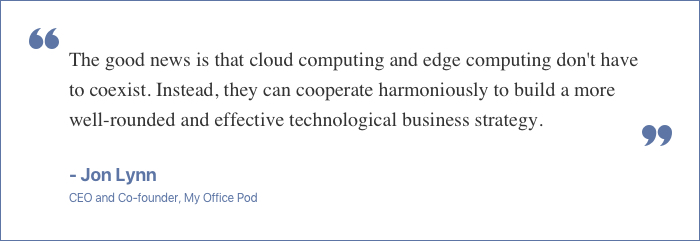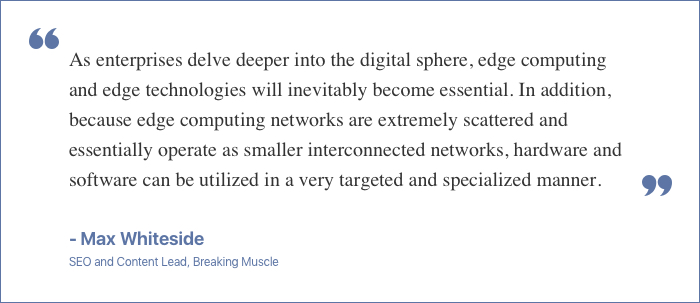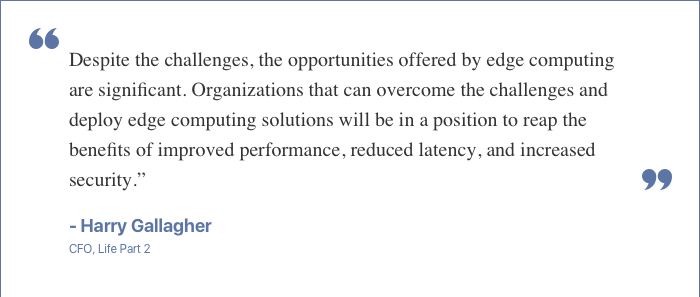ABSTRACT:
With developments in AI, communication technologies, deep learning, big data, and 5G mobile applications, billions of data bytes are created every day globally. This necessitates a massive push for structural optimization in the existing computational paradigms and also drives the need for optimal solutions to solve latency issues associated with voluminous data processing. This is where edge computing emerges as a new computing paradigm that processes the data at the network edge. This brings the distributed architecture close in terms of geographical distance. Edge computing works in collaboration with a spectrum of other new-age technologies to bring computing closer to end users/devices. Edge computing brings the best of cloud and edge computing together to benefit businesses to the fullest.
GoodFirms survey titled- ‘Edge Computing - Benefits, Applications, Challenges, and Opportunities' attempts to uncover valuable insights on the application use cases, benefits, challenges, and opportunities in the edge computing field. The research also forays into the current driving factors for the technology and highlights issues in existing computing architecture. The survey also reveals how edge computing supplements cloud computing to provide a better processing structure. An online survey was conducted from 15th September 2022 to 21st September 2022. A total of 390 businesses were queried regarding their existing computing infrastructure, edge computing initiatives, and future plans to shift to different computing technology.
Table of Contents:
Introduction
Overview of Edge Computing
- Edge Computing: Supplementing Cloud Computing Architecture
- Edge Computing Market Share
- Edge Vs. Cloud Computing
Factors Considered for Switching to a Different Computing Technology
- Faster Responses
- Cost Effectiveness
- Data Privacy
- Reliability
- Added Functionalities
- Less Bandwidth Requirement
- Software and Hardware Requirements
Driving Factors for Edge Computing
#1 Issues Associated With Other Data Computing Technologies, including Cloud Computing
#2 Cost Effectiveness
#3 Increase in the Use of IoT Drives Edge Computing
#4 Introduction to 5G
- Reduced Latency
- Processing Volumes of Data Without Hassle
- Privacy
- Remote Operations
- Cost Sensitivity
Top Application Use Cases of Edge Computing
- Healthcare
- Industrial and On-Field IoT
- Autonomous Vehicles
- Point of Sales
- Security Systems
- Smart Cities
Challenges that Organizations Can Come Across Even After Adoption of Edge Computing
Introduction
Data is an integral part of any business, and with the increasing need to go digital in the post-pandemic era, the volumes of data are only increasing. These data volumes are expected to explode with the advent of 5G and the high number of connected mobile devices. Although cloud computing is an efficient technology for storing processed data, it is not sufficient to handle the processing needs of the humongous data of modern organizations. Here comes the need for Edge Computing. Edge computing is the decentralized computing framework that helps process and analyzes data closer to where it is created. Edge computing is thus a way to improve response time and reduce latency. It can help businesses obtain faster insights.
The survey titled ‘Edge Computing - Benefits, Applications, Challenges, and Opportunities’ by GoodFirms aims to obtain insights regarding aspects of edge computing like its benefits, applications, challenges, and opportunities. The survey findings will help businesses analyze the benefits and applications of the technology and help them make better choices.
Overview of Edge Computing
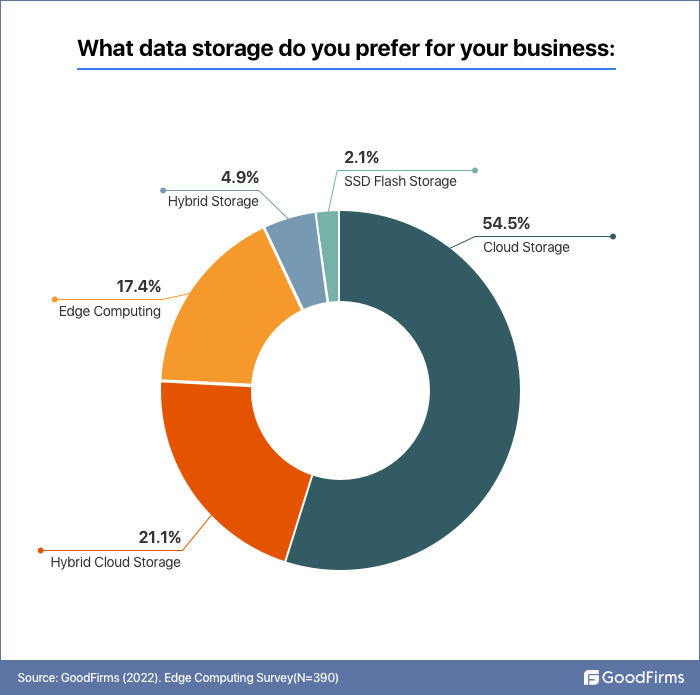
The world has come a long way from using CDs and hard drives to traditional on-premise data centers and cloud data centers. Migrating the data to the cloud was a significant change in networking. While the introduction of cloud computing has made things easier for organizations, some hurdles are still awaited.
The survey conducted by GoodFirms shows that the cloud is the most preferred option for data storage. Around 54.5% of respondents said they have adopted Cloud computing in their businesses for storing their valuable data. At the same time, 17.4% of surveyees have now turned towards Edge computing for data storage. With the rise in adoption of cloud computing and edge computing, usage of SSD Flash storage has gone as low as 2.1%.
Why are businesses gradually turning towards Edge Computing?
With the advent of cloud computing and the rise of IoT devices, almost everything we use is digital and creates a huge volume of data. This has added to the datasets stored in the cloud. These massive chunks of data require substantial bandwidth for transmission to the cloud. Voluminous data transmission to a distant cloud, its quick processing and response may not be feasible, and it does negatively impact applications where real-time or near real-time responses are necessary.
The above issues can be resolved by edge computing. By its very nature, edge computing is a distributed and decentralized approach to delivering computing power. As opposed to cloud computing, which relies on centralized servers located in data centers, edge computing distributes processing power across the network from servers located closer to the data source. Edge refers to the place where end devices access network elements such as computer systems, robots, sensors, etc. This makes it ideal for applications that require real-time processing or high-bandwidth connections, such as image analysis or video transcoding.
It also has several advantages compared to cloud computing models. These include reduced latency, greater resource efficiency, and greater control over where data is stored and accessed. For these reasons, edge computing is becoming a popular way for organizations to deliver high-performance analytics and AI solutions without sacrificing security or privacy.
“Edge computing is a hybrid model that uses the best parts of both cloud computing and computing that are done on-site,” states Zhanna Sedrakyan, Director of Operations Manager at Contact Consumers.
Edge Computing: Supplementing Cloud Computing Architecture
Edge computing is a distributed framework that helps store and compute data right where the source is. IT Edge is the terminal of a device where it gets connected to the network and where instructions from a server are received. This server can be a traditional on-premise data center or a cloud server. Edge computing is the networking framework where the computing capabilities are allocated to the edge servers.
This technology reduces the data volumes transmitting to the cloud and helps applications where latency is not expected. Although cloud computing is a centralized architecture, it can not always be beneficial and efficient for all computing needs.
Edge computing works to reduce the distance between the source of data and the point where it is processed. It is an architecture, more than a technology. It can not be a replacement for Cloud computing but instead an enhancement to the prevalent Cloud computing. The employment of edge computing is necessary for reducing the high volumes of data going to the cloud.
A study by Gartner predicts that about 75% of the data created by organizations will be computed outside the traditional centralized data centers or cloud by 2025.(1) This insight shows the growing popularity and need for edge computing. Combined with Cloud computing, Edge servers can do wonders to reduce the load on the cloud computing network.
Edge Computing Market Share
A report by a market research company, Fact.MR gives insights into the Edge Computing market trends.(2) The research shows a forecast for the period between 2022 to 2032. The market is expected to grow at a rate of 30.2% CAGR till 2032, and the market may touch a value of US$ 69 Billion.
The highest contributor to the market share is expected to be the hardware components which may have a share of about 46%. Industry 4.0 needs artificial intelligence to be employed, which can boost the hardware components requirement. Amongst the several drivers of edge computing, the most propelling one has to be Energy and Utilities. It shares a good 18%. This segment is expected to grow at a CAGR of 29% through the year 2032.
“The majority of businesses' data will be created on-premises by 2023. With edge computing, this data set can be transmitted in what amounts to real-time”, predicts Jake Cowans, Founder and COO of Company Scouts.
Edge computing is still in its infancy and has the potential to spread faster among businesses. The GoodFirms’ survey shows that 31.5% of respondents are at the Beginner level of their journey of Edge computing. While 21.4% of surveyees are still in the Learning phase, an almost similar number of surveyees are yet to begin their journey.
The most exciting factor of this survey is that 17.9% of the participants say that they have reached a proficiency level in Edge computing, and 7.9% of participants claimed to have attained the Expert level in the technology.
Edge Vs. Cloud Computing
Cloud Computing
- Cloud computing is a widely adopted computing technology now. A large number of organizations are leveraging the benefits of cloud computing now.
- Cloud computing allows organizations to store high volumes of data in a data center that a third party hosts.
- The pay-per-click model allows users to pay for only what they are using.
- Cloud computing is a centralized system that ensures data storage in a single place.
- Cloud computing relies on network connectivity and can be an issue at a remote location.
Edge Computing
- Edge computing is a distributed network that computes the data closer to the source of data. It is useful to derive targeted data.
- The reduced distance between the device and edge node reduces the latency in processing and transmitting data.
- Edge computing is an extension of cloud computing, where time-critical data is processed at the edge nodes, and the remaining data is processed in the cloud.
- Edge computing is a technology that is suitable to be used in applications that are located remotely, like oil wells.
44.2% of participants believe that cloud computing is impractical with high data volumes.
Cloud computing is the most preferred computing technology among organizations worldwide. However, it is unsuitable when the data volumes are extremely high. With the exponential increase in the use of IoT devices, data volumes are increasing further, making cloud computing impractical. Edge computing is more reliable in such situations to handle huge chunks of data.
Factors Considered for Switching to a Different Computing Technology
GoodFirms survey queried businesses of all sizes on what prompts them to switch their computing technology. While most are reaping the benefits of cloud computing, fog computing, etc., many would like to switch their computing technology for better results. Our survey identified the top factors that businesses will consider before switching to different computing technology:
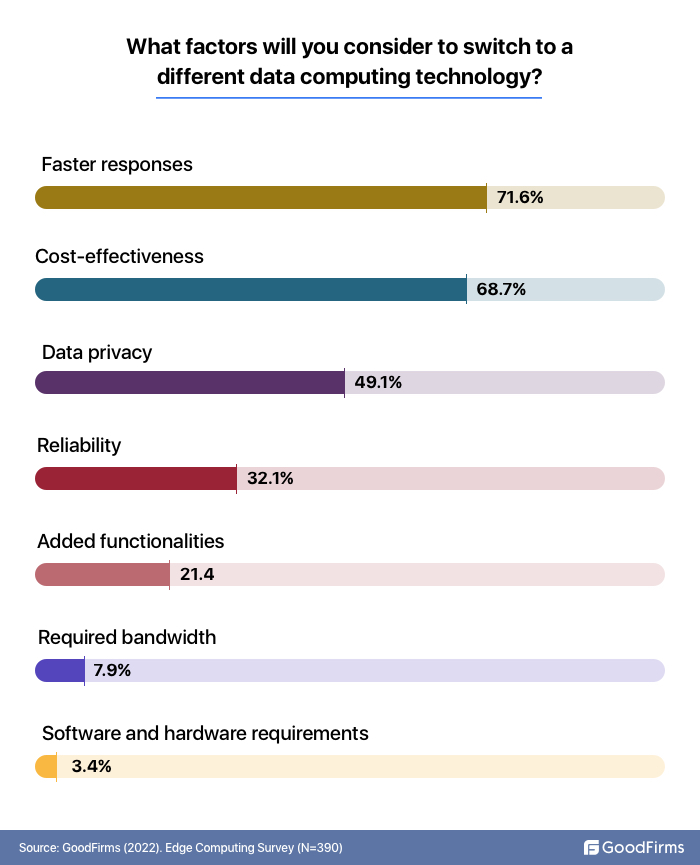
Faster Responses
71.6% of organizations indicated faster responses as one of the factors in switching to a different data computing technology
Experiencing delays in receiving processed data can result in losses. Businesses where real-time or near real-time responses are a critical requirement, cannot afford delays in data responses. Therefore, this factor happens to be a prominent reason to switch to a new data computing technology.
Cost Effectiveness
68.7% of organizations shifted to a different data computing solution as it is cost-saving
Every organization spends a considerable amount on the storage and processing of data. However, it is also necessary to fit it into the budget. Although cloud computing mitigates issues associated with on-premise data computing systems, the costs associated with data storage in cloud computing can be high for those who have limited budgets. So, undoubtedly, the cost is an important factor to consider while switching to other computing technology.
Data Privacy
49.1% of respondents indicated data privacy as a prominent factor in shifting to another data computing technology for their business
Data privacy is critical for all organizations. Maintaining the security of data while processing is sometimes full of risk. Sending data to a cloud or even traditional data centers makes it vulnerable to threats to the privacy of data. Organizations consider data privacy as a critical factor for the data computing infrastructure.
Reliability
32.1% of organizations prefer to switch to a different data computing solution for wanting a reliable computing solution
The data computing technology used by any organization must be reliable enough to handle critical data. Risks, such as data loss, delayed responses, timeouts, missing resources, etc., may affect reliability. Other reliability factors, such as speed, reporting, accuracy, uptime, etc., also affect the decision to switch computing technology. Organizations want assurance that cloud services are more fault-tolerant and able to provide services even when multiple components fail together.
Added Functionalities
21.4% of respondents prefer to switch to a different data computing platform for better functionalities
Added functionalities range from on-demand service, free maintenance, reliability, and automation to free virtual resources, advanced security options, Data backup and disaster recovery, and easy payment options. Added functionalities can influence the decision of companies to reconsider their current computing service. Organizations will be more inclined to choose a computing service provider that offers the maximum functionalities.
Less Bandwidth Requirement
7.9% organizations indicated optimal bandwidth requirements as the reason to move to a fresh data computing platform
Bandwidth consumption is directly proportional to the volume of data sent to networks (cloud or traditional data centers). The higher the data volume for processing, the higher will be the bandwidth requirement and the subsequent cost for the organization. Optimal bandwidths are required for data computing networks to be efficient and cost-effective. Even transitioning from legacy systems to cloud or edge computing without addressing bandwidth requirements may cause serious issues. 7.9% of surveyed organizations may switch their computing technology to achieve optimal bandwidth performance.
Software and Hardware Requirements
3.1% of organizations are ready to switch to another computing technology for software and hardware requirements
Computing technologies have their own hardware and software requirements. With the emergence of new edge technologies such as cloud computing, hardware requirements have significantly reduced. Traditional data storage technologies like SSD Flash or Hybrid storage systems are now taking a back seat. 3.1% of businesses factorize software or hardware requirements before replacing their current computing technology.
All the above factors present a favorable arena for the growth of edge computing. Most of the factors businesses consider for switching to other computing technology are USPs of edge computing. From reducing bandwidth requirements to establishing more reliable networks, edge computing solves multiple issues related to data computing networks. Our research further revealed the key driving factors that are causing a gradual shift towards edge computing technology.
Below are the driving factors that promote edge computing growth initiatives:
Driving Factors for Edge Computing
#1 Issues Associated With Other Data Computing Technologies, including Cloud Computing
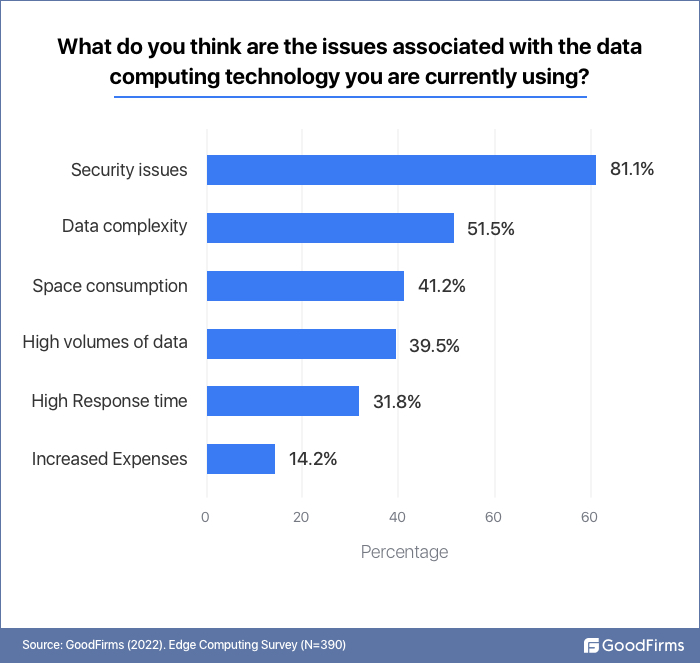
Security Issues
81.1% organizations reported security issues in their current data computing technology
Data security is the foremost concern for organizations that maintain data digitally. Irrespective of the company size, the importance of data privacy is non-debatable. More than three fourth of surveyed companies reported security concerns with their current computing technology. Even cloud computing, which is secure most of the time, is not completely immune to security breaches as the data is mostly transmitted through public networks. On the contrary, edge computing is more secure on many fronts than cloud computing as it doesn’t require data to be transmitted via public networks.
Data Complexity
51.5% surveyees reported ‘data complexity’ issues in their current computing system
One of the biggest challenges faced by organizations with data computing technologies is managing data complexity. The presence of multiple servers, databases, end devices, applications, platforms, etc., gives rise to data complexity. With so many different apps and services being hosted in modern business environments, keeping track of all the different data stored across multiple platforms is challenging. Siloed business units, data gaps, and efficiency issues add more complexity to current data computing processes.
Edge computing eliminates data complexities by leveraging the processing power of devices like smartphones and IoT devices to offload work from centralized servers located in the cloud. By connecting these devices directly to the network, edge computing allows faster processing times. It reduces latency for data transfers, resulting in more efficient use of resources and an overall better experience for end users with lesser complexities.
Space Consumption
41.2% respondents reported facing space consumption issues with their current data computing technology
Organizations rely on computing for various services and business operations. Computing also generates a vast amount of data that consumes data storage space. Continuous and real-time backups also require space. Space consumption is an issue when the organization has a limited data storage capacity. It can also be a concern for an organization where the data computing technology deployed is hybrid storage or SSD flash storage. File replicas created during the computing process, data duplication, large files, etc. amplify the space consumption issues.
High Volumes of Data
39.5% of surveyed organizations are struggling with managing high volumes of data
For large-scale organizations, data generated is comparatively higher than for mid-sized or small-sized businesses. For instance, let us consider the number of cameras installed to monitor the office's premises. All these cameras collectively generate loads of data. This data increases manifold when multiple instruments in multiple departments at various locations are taken into account.
With the ever-increasing IoT devices, IDC predicts that the world’s data will rise 61% to 175 zettabytes by 2025.(3) The number is enormous to be processed and consumes a lot of energy. This massive amount of data creates a huge load on the computing system, especially those running on outdated legacy infrastructure. Edge computing is better positioned to handle high-data volumes.
High Response Time
31.8% of organizations complained of high response time with their current data computing technology
Even a minor delay can create significant issues when processing data for devices requiring immediate responses. Inventions like self-driving cars cannot afford the time data takes to process at a distant location. High-response times can make it difficult for organizations that require real-time data decision capabilities. For instance, stock trading companies need to process data in nanoseconds to make buying and selling decisions based on live ticker prices. Even a nanosecond delay can cost millions of dollars. Edge computing reduces latency and lowers response time.
Increased Expenses
14.2% organizations report ‘increased expenses’ as a challenge they face with their current computing system
The expenditure of a company on data computing technology varies based on the size of the organization and the technology they are using. Even those who have shifted to cloud alternatives report high subscription bills. When cloud computing came in to replace the traditional on-premise environment, it made businesses ecstatic about the reduced prices of power consumption, hardware maintenance, or other related costs. Although cloud computing offers cost stability due to the pay-per-use pricing model, data storage and transmission are expensive.

#2 Cost Effectiveness
66.1% of organizations believe that ‘low cost’ will drive the growth of edge computing.
Edge computing has the potential to reduce direct operating costs by reducing bandwidth requirements and indirect costs caused due to latency issues, server downtimes, etc.
“One of the things that organizations spend a lot of money on is moving data around on cloud hosting services. However, because there is less need to transfer data to the cloud when using edge computing, businesses spend less on operational expenditures,” says Emir Bacic, Co-founder of Pricelisto.
#3 Increase in the Use of IoT Drives Edge Computing
Increase in the use of IoT is promoting the growth of edge computing, say 52.8% of respondents.
In recent times, we have undoubtedly seen a high use of IoT devices. These are the times we observe devices like printers, medical equipment, cameras, and even toasters going digital and processing data for improved functioning. Statista states that more than 75 billion IoT devices will be installed worldwide by 2025.(4). With the heavy increase of IoT devices, data to be computed will also increase exponentially. Edge computing will be the best choice to provide an efficient computing environment for these devices.
#4 Introduction to 5G
‘5G Developments are driving edge computing growth’, assert 47.7% of surveyees
Right from when the first generation of cellular networks came into existence, the world has seen resultant inventions every year. 5G is expected to revolutionize concepts like AR/VR, autonomous vehicles, IoT, etc. Edge nodes have high-performance server-class computing power coupled with exceptional network capabilities. Therefore, edge computing is perfectly suitable for the deployment of 5G networks that require optimized delivery from the core network. The growth in the 5G environment and its wider adoption will support the growth of edge computing. “5G and edge computing have a symbiotic relationship. The transformational aspects of 5G use cases are closely tied to the edge. Without edge computing, 5G wouldn’t be able to meet the promises it is expected to deliver,” says Rob Kasegrande, MD, Deloitte Consulting LLP, Deloitte Technology, Media & Telecommunications (TMT). Rob also manages Deloitte's 5G and Edge Computing practice.(5)
Benefits of Edge Computing
#1 Reduced Latency
High-end applications may require quick responses from the servers. However, with the rise in the amount of data present on the cloud, data processing may create latency which is not acceptable for applications like remote surgery or tactile internet. Edge computing reduces latency by moving processing action near the edge.
#2 Processing Volumes of Data Without Hassle
With IoT devices' increased computing power, data volumes, and complexities, the burden on existing infrastructure and the network has increased considerably. Additionally, sending all this data to a centralized location creates bandwidth and latency issues. Processing all data in centralized clouds is not feasible; computing at the edge enables processing high-volume data without hassle. According to Gartner, around 75% of the data will be processed outside the traditional data centers or cloud.(6)
“Edge computing is a huge boon to companies who need to process large amounts of data in real-time, such as AI and machine learning companies,” says Anthony Vaccaro, VP of US Sales at TimeWatch.
#3 Privacy
Sending all the data to the cloud or an on-premise data center is at a high risk of privacy breaches. The networks are also vulnerable to attacks. There is even a chance of data loss while being transmitted to or from the cloud. Such challenges can be easily mitigated with Edge computing. Organizations can decide on what data they can send to the cloud. Critical and confidential data can be processed locally at the edge nodes.
#4 Remote Operations
In remotely placed use cases, there are connectivity issues (low or intermittent connectivity). With edge computing, data processing does not solely rely on network connectivity and can be done remotely, increasing the system's reliability.
#5 Cost Sensitivity
Edge computing adoption allows one to compute data near the source, avoiding sending data to the cloud at a distance. Reduction in the distance reduces the required bandwidth, and associated infrastructure costs, making edge computing a cost-effective alternative.
Top Application Use Cases of Edge Computing
#Healthcare
Remote surgeries have been a topic of discussion for a while now. The introduction of 5G has even boosted the possibility of such innovations. Edge computing is the choice for AR-assisted surgeries requiring real-time data collaboration and zero latency issues. Edge computing provides zero latency data traders for high-end medical devices.
#Industrial and On-Field IoT
With Industry 4.0, the manufacturing sector is moving forward with increased resource efficiency and intelligence. Be it the intelligent bots on the factory floor or the sensors on the oil well rigs, everything works on the intelligent tools that require voluminous data processing. However, not all data is used for actual decision-making and insights.
According to a study by McKinsey & Company, out of the data generated by 30,000 sensors, only 1% of the data is utilized for decision-making.(7) Sending substantial data volumes to a distant data center or a cloud can be energy-consuming. Using the networking that will process the data just where it is created can be avoided.
Edge computing is also more compatible with predictive maintenance needs in the manufacturing industry. Predictive maintenance is where the performance of the machines or instruments is continually measured and analyzed to forecast maintenance activities. Predictive maintenance using edge computing will aid in reducing the passive downtime of the system involved in preventive maintenance and increase productivity.
#Autonomous Vehicles
The most talked about edge computing application is autonomous vehicles. When a vehicle is self-driven, it comes with many sensors that collect data. The data needs to be processed to avoid any mishappenings with the machine. Toyota predicts that the car-to-cloud data stream will be about 10 exabytes per month by the year 2025.(8). Sending this tremendous data to the cloud can cost huge in terms of money and energy. Edge comes as a suitable alternative to process the data.
#Point of Sales
A retail outlet's point of Sales (POS) can deploy edge computing for faster customer service. It can also be used to maintain customer social media and customer sentiment data. It will definitely enhance the customer experience. Data is captured at the kiosk, and getting processed at the edge will reduce any time lags.
#Security Systems
Many businesses have adopted face recognition or fingerprint recognition systems for security purposes. Sending the data to the cloud every time recognition is done can be expensive. Computing this data at the edge will improve the system's efficiency and reduce the cost of operation.
Another use case of edge computing is in camera-monitored premises. Sending all the data from a number of cameras can raise the load on the network and the cloud servers to process all the wanted and unwanted data. All generated data can be saved and processed on the edge terminal to lower this load. Computing data locally will help the edge device to analyze the meaningful data and send only the required data to the cloud, optimizing the load and cost of the security framework.
#Smart Cities
Managing cities with aging infrastructure, interconnected problems, and increased citizen expectations is arduous. To overcome all these issues, smart city solutions are gaining popularity. Smart cities involve many IoT devices deployed for the smooth functioning of the city. The edge computing paradigm's evolution will enhance a smart city's features. Adopting a smart city network can assist in advanced traffic management in densely populated regions. Such applications generate vast amounts of data which necessitates a latency-free network.(9) Edge computing is thus becoming a superior technology for incorporating devices. Edge computing plays a crucial role in delivering solutions for road traffic control, security, and safety of the city and preventing disasters like floods.
Challenges that Organizations Can Come Across Even After Adoption of Edge Computing
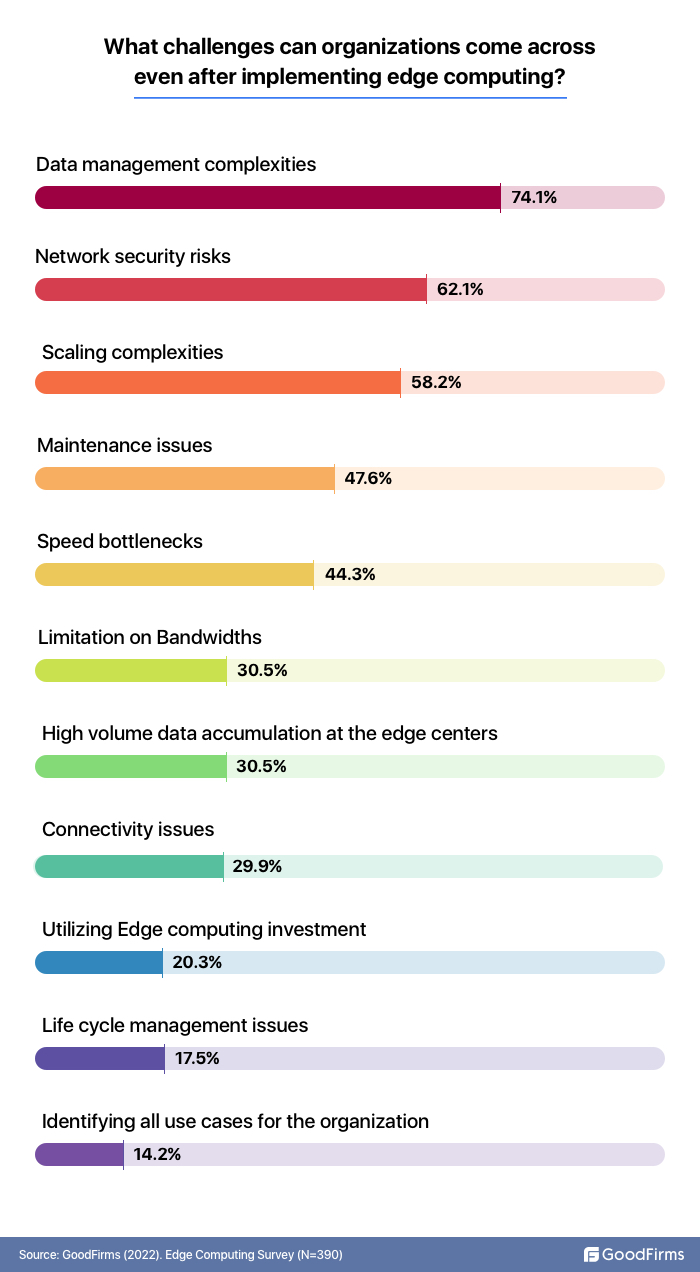
Data Management Complexities
74.1% of respondents feel that even after the implementation of Edge computing, they will have to face data management complexities
Edge computing has emerged as a solution for computing the ever-increasing volumes of data. Having said that, edge computing is not an entirely unique concept but an extension of cloud computing technology. Edge computing will require businesses to decide what data is critical and needs to be processed near the source for quick results and what data can be sent to the cloud for processing and storage. This might, in a way, increase the data management complexity. Also, organizations will have to monitor and manage two technologies.
Network Security Risks
62.1% of businesses think that network security risks in edge computing will be a challenge
Although security risks of transferring data from the devices to the cloud are decreased in the edge infrastructure, there are security risks involved at the edge. The data to be processed at the edge becomes vulnerable to security breaches as all the edge devices do not have built-in authentication, and the security capabilities may vary from device to device. Anyone getting access to the edge device can breach the system.
Scaling Complexities
52.8% of participants are of the view that scaling the Edge will be challenging for them
With the increase in the data that will be computed on the Edge nodes, there will be a need for scaling the network. Vertical Scaling and Horizontal Scaling are the two main approaches to scaling the edge.
- Vertical scaling offloads the data from the edge servers to Cloudlets, which increases the dependency on Cloud computing.
- Horizontal scaling uses resources across the devices to perform computing on demand. This technology, however, needs more research and development.
To deploy Edge computing widely, scaling complexities must be thought upon with proper planning.
Maintenance
47.6% of respondents are of the opinion that maintenance of edge networks will not be easy
Adopting edge technology for networking involves the need for skilled professionals to install and maintain the edge devices and servers to use it to the fullest extent. This will require maintaining the infrastructure. It must also be considered that a distributed network will always have multiple edge receivers at a certain distance. Troubleshooting any problem in such a framework involves maintenance and respective costs.
Speed Bottlenecks
44.3% of organizations fear speed bottlenecks due to uneven bandwidth distribution
With the increase in IoT devices and others that require real-time data processing, edge computing is a convenient option. However, when organizations adopt edge computing to optimize bandwidth cost, they generally allocate higher bandwidth to data centers and lower to edge servers, creating a speed bottleneck that may result in increased latency. 30.5% also mentioned limitation of bandwidth could cause speed issues in edge computing Edge computing servers require a certain bandwidth to perform at full capacity. In the absence of the required bandwidth, edge servers may not perform well.
High Volume Data Accumulation at Edge centers
30.5% of organizations expressed concerns about the management of the high volume of data accumulation at edge centers
While the edge infrastructure can help reduce data volumes at the cloud, there are chances that data gets accumulated at the Edge nodes due to limitations of hardware and software.
Connectivity Issues
29.9% of organizations believe connectivity issues will be persistent in edge computing
Edge computing is designed to reduce latency in distributed networks. However, there may be disruptions in the network due to connectivity issues.
Utilizing Edge Computing Investments
The utilization of edge computing investments is a concern for 20.3% of surveyees
Adopting any new technology involves considerable investments. Implementation of edge requires deployment, configuration, and maintenance of the infrastructure. Even though edge networking reduces the cost associated with bandwidth requirements, the implementation involves hardware and other considerable costs, which must be compensated by utilizing the infrastructure to the fullest.
Lifecycle Management Issues
17.5% of organizations mentioned lifecycle management concerns associated with edge computing
Life cycle management consists of various aspects ranging from installation to maintenance of the edge system. The service providers from edge computing have to deal with deploying network functions and proper testing of the system. It is also necessary to ensure zero downtime and system upgrades without disruptions. It is thus important to go for microservice-based deployments on edge. Managing every aspect of the process is not an easy task.
Identifying all Use Cases for the Organization
14.2% of surveyees stated that identifying all edge use cases for their organization will be a challenge
Merely implementing edge computing for the network requirements of an organization is not enough. The businesses must be able to identify what are the use cases of the edge network infrastructure. However, there is a lack of standardization in the edge devices and protocols. There are two main challenges in establishing a set of standard protocols. a) It is difficult to agree upon a standard with many vendors owing to the flexible and diversified customizations b) The interfaces used by several heterogeneous user equipment to communicate with the edge cloud come in a varied range. Without standard protocols, it will be difficult to identify all use cases for organizations implementing edge for the first time.
Opportunities in Edge Computing
Establishing Standards and Benchmarks
Although Edge computing is gaining popularity among businesses, there is a lack of standardization of protocols for the technology. However, industry leaders are making efforts to create standards and social and legal aspects of deploying the technology. The accomplishment of this task can drive the implementation of edge computing on a wide scale and create more opportunities in the field. This area needs to be explored to find solutions for establishing a framework that supports edge’s distributed systems.
Appropriate Hardware and Software
The growth of edge computing requires lightweight software algorithms that can perform the necessary machine learning and data processing tasks. There are developing opportunities for IT companies that can create lightweight applications (without compromising the features) for edge computing usage.
Transportation
Autonomous cars have always been the most discussed applications of edge computing. However, more can happen with the advancement in edge computing. The application of edge computing in autonomous vehicles can help in collision avoidance, speed control systems, and smart parking management. Additionally, it will also aid in improving air quality with effective driving.(10) The use of edge computing in transportation will solve the problem of traffic on roads and make the trucks driverless as the trucks can communicate with one another with negligible latency.
Energy and Resource Efficiency
Effective use of edge computing has several opportunities. While autonomous vehicles can help reduce fossil fuel consumption, Edge computing can also aid in enabling farming in drought-stricken areas by using a monitored drip system. Another prominent use case for edge computing in agriculture is precision agriculture. Precision agriculture helps in the usage of the exact amount of input levels of water and fertilizers for increased crop yield. The integration of rainfall prediction and precision agriculture can further increase productivity. Edge computing can be a perfect technology to facilitate the adoption of precision agriculture.(11)
Healthcare
The Covid19 pandemic has proved the significance of remote medical checkups. The growing use of sensors in medical devices has aided in faster diagnosis and treatments. With the betterment of understanding and employment of edge computing, we can expect things like
- Prevention of heart attacks as a result of emergency calls and responses
- Continual cancer cell monitoring,
- Monitoring of critical health parameters
The healthcare devices that can be powered with edge computing range from wearables to tablets. Wearables offer functionalities that can monitor patient vitals like blood pressure and blood sugar levels. Consistent monitoring of these vitals can aid in on-time diagnosis and treatment.(12)
Metaverse
The excitement for the metaverse is higher than ever, owing to the investments made by tech leaders in this field. Metaverse is a collection of interactive technologies like AR/VR systems spread across a large geographical area. These systems will create massive amounts of data that puts a lot of pressure on the network. Edge computing is the technology that will provide a solution to handle this pressure.
Future of Edge Computing
Edge computing is still in the early stages. Only a small number of organizations have adopted this technology. However, Edge computing is expected to have a broad scope in various sectors in the upcoming times. “The way data is handled, processed, and delivered has changed, and edge computing is driving the change. Edge computing has the potential to accommodate all the digital needs of an organization.” says Snehal Kamble, Content Strategist and Corporate Communicator at Straits Research. The GoodFirms survey received responses from organizations on what they think about the future of Edge computing.
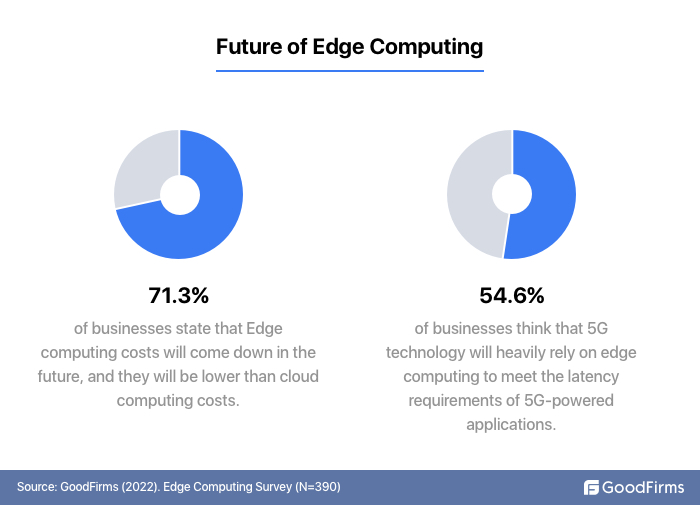
71.3% of surveyees stated that edge computing costs would come down in the future
Edge computing is a cost-effective computing system. Currently, the majority of organizations have invested in cloud computing. Adopting edge computing will surely cost a considerable amount to install the infrastructure. However, in the long run, the costs will be compensated. 71.3% of organizations said that edge computing costs would be lower than cloud computing costs in the future.
54.6% of organizations think 5G technology will heavily rely on Edge computing
Edge computing is the computing paradigm engineered to work on huge volumes of data. For 5G-powered applications requiring real-time processing, data processing will have to be with a negligible latency edge. With the growth in 5G, edge computing is predicted to grow even faster. Increased speed and reduced latency are the top reasons that make this combination of 5G and Edge computing a big hit. 54.6% of organizations think that 5G technology will heavily rely on Edge computing to meet the latency requirements of 5G-powered applications.
Key Findings
- Edge computing is an efficient way to process data when the data volumes are high, and the applications require real-time or near real-time responses.
- Edge computing is a distributed network that allows data processing at edge nodes placed at several locations.
- Using edge computing considerably reduces the latency in receiving responses, making it a choice when applications do not tolerate latency.
- Edge computing reduces the network security risks associated with cloud computing.
- Edge computing is not a replacement for cloud computing but an enhancement.
- 54.5% of organizations have adopted Cloud computing, while 17.4% have now switched to Edge computing.
- Factors like the increased use of IoT devices, the emergence of 5G, and cost sensitivity are the major promoters of Edge computing.
- The most common issues that organizations face while using other computing technologies are lack of security, high volumes of data, high response time, and data complexity.
- Edge computing brings the data processing close to where the source of the data resides, reducing the distance between the source and destination.
- 44.2% of businesses think cloud computing is impractical when the data volumes are high.
- 71.6% of organizations indicated faster responses as one of the factors in switching to a different data computing technology
- 81.1% of organizations reported security issues in their current data computing technology.
- The prime benefits of Edge computing include reduced latency, improved response time, and reduced bandwidth requirement.
- One of the major challenges in adopting Edge computing is the lack of standardization of protocols among various vendors.
- 71.3% of surveyees stated that edge computing costs would come down in the future
- 54.6% of organizations think 5G technology will heavily rely on Edge computing.
Conclusion
Edge computing has been touted as a transformative technology that could help industries and businesses become more efficient. By taking data stored in the cloud and processing it on the device itself, edge computing opens up new opportunities for data analytics and machine learning. Edge computing also brings new security concerns, like the potential for attackers to hijack devices at the edge.
Many edge and fog computing companies are working on unlocking the power of existing networks to offload some of their workloads. It can help save money by minimizing the use of expensive data centers and servers. It can also allow organizations to access more resources than they could otherwise, leading to more efficient and effective operations.
We sincerely thank our Research Partners who participated in the survey.
References
- https://www.gartner.com/smarterwithgartner/what-edge-computing-means-for-infrastructure-and-operations-leaders
- https://www.factmr.com/report/4761/edge-computing-market
- https://www.networkworld.com/article/3325397/idc-expect-175-zettabytes-of-data-worldwide-by-2025.html
- https://www.statista.com/statistics/471264/iot-number-of-connected-devices-worldwide/
- https://www2.deloitte.com/us/en/pages/consulting/articles/what-is-5g-edge-computing.html
- https://www.gartner.com/smarterwithgartner/what-edge-computing-means-for-infrastructure-and-operations-leaders
- https://www.mckinsey.com/~/media/McKinsey/Industries/Technology%20Media%20and%20Telecommunications/High%20Tech/Our%20Insights/The%20Internet%20of%20Things%20The%20value%20of%20digitizing%20the%20physical%20world/Unlocking_the_potential_of_the_Internet_of_Things_Executive_summary.ashx
- https://global.toyota/en/detail/18135029/
- https://ieeexplore.ieee.org/abstract/document/9063670
- https://www.researchgate.net/publication/347534934_Edge_Computing_in_Transportation_Security_Issues_and_Challenges
- https://www.degruyter.com/document/doi/10.1515/jisys-2022-0046/html?lang=en
- https://www.intel.com/content/www/us/en/healthcare-it/edge-analytics.html
